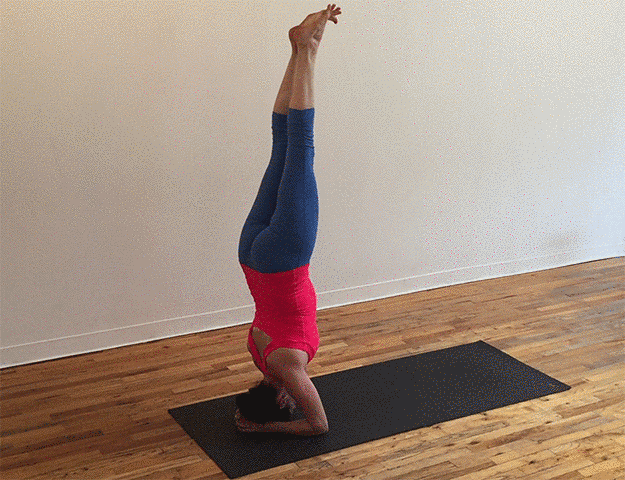Challenge yourself to get upside down.
Jenny Chang / BuzzFeed
So you want to do a headstand…
First, make sure your body is ready to attempt a headstand. .
Once you feel confident that you’re ready to give it a go, Jess Blake, yoga instructor at YogaWorks NYC, suggests you practice the following five moves. When you first start out, do these moves against a wall or have a friend spot you to reduce the risk of injury.
Headstands are great for party tricks, facing your fear of falling, and taking really cool photos for Instagram (amongst many other things.) So get started! You got this.
Come into table top position.

John Gara / BuzzFeed
Clasp your hands and place your head on the mat.

John Gara / BuzzFeed
• Lower to your forearms and place your elbows directly under your shoulders. • Interlace your fingers, but leave space the size of an egg between your palms. (The outer edge of your hands, wrists, forearms and elbows will be your only foundation for headstand.) • Place the crown of your head on the floor with the back of your head against your hands.
Move into half-forearm headstand position.

John Gara / BuzzFeed
• Root strongly into your forearms and outer wrists, lifting your shoulder blades away from your ears to protect your neck. • Lift your knees and hips up, lengthen your spine, and keep your elbows right under your shoulders. If your shoulders start to slide apart, consider practicing to build up more strength in your shoulder/arm muscles. • Walk your feet forward towards your arms so that your hips start to stack over your shoulders. • If your upper back starts to round – causing your shoulders to sink forward past your elbows – stick with to build more flexibility in your upper back and chest. • Root strongly into forearms/wrists/hands and lift your shoulder blades aways from your ears, keeping most of the weight in your arms so that the pressure on your head is light.
Kick your legs up and hold the headstand.

John Gara / BuzzFeed
• Slowly lift one leg. Make sure you keep it straight and avoid turning it out. • Root into your foundation and move shoulder blades up away from the ears, tightening your core. • Push onto the ball of your bottom foot (keep rooting through foundation) and lift up through entire torso, engaging abdominal muscles strongly to lift bottom leg up. • Join your legs and squeeze through your heels and balls of your feet. • Root into your foundation and lift strongly upwards through entire body. • Reach your tailbone up towards your heals so that your abdomen stays engaged.
Stay as long as you feel stable and can maintain steady breathing. Don’t overstay your welcome – coming out safely is as important as coming in safely!
Slowly and with control, lower your legs to the ground one by one.

John Gara / BuzzFeed
• To come out of the headstand, squeeze through your arms, lifting your shoulder blades away from your ears. • Keep one leg lifted upwards as you tighten your core and slowly begin to lower your other leg back down. (That top leg reaching upwards is the counterbalance that will keep you steady as the other leg descends.) • Bring other leg down. • Alternately, you can bend your knees at the same time and hug your legs into your body, engaging your abdominal muscles as you lower both feet back down. • Lower your knees to floor and rest in .
Here’s Jess doing the full forearm headstand.

Shannon Rosenberg / BuzzFeed
Like a boss.


















